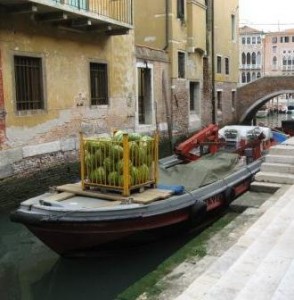“Motondoso” has very clear, and essentially simple, causes and effects. Anything moving in water, even eels, will create some kind of wake. The wake is the visible, surface part of the turbulence made by whatever is moving — in the present case, the motor’s propellers. The waves spread out in two directions until they dissipate.
In the case of motorboats in Venice, this fact is exacerbated by:

The number of boats: There are thousands of registered boats in the city of Venice. There are also many which are unregistered. This number spikes every year in the summer when trippers from the hinterland come into the lagoon to spend their weekends roaming around, often at high speed but always with many horsepower, in motorboats of every shape and tonnage. Teenage boys, particularly from the islands (by which we mean Sant’ Erasmo, Burano, Murano, are especially addicted to roaming at high speed at all hours with their girlfriends and boomboxes.
On a Sunday in July a few years ago, a squad of volunteers from the Venice Project Center spread out at observation posts across the lagoon, from Chioggia to Burano. Their mission was to count the number and type of boats that passed their station. Whether it was a million boats passing once or one boat a million times, it didn’t matter. They came home with quite a list: every kind of small-to-smallish boat with motors ranging from 15 to 150 hp, hulking great Zodiacs, large cabin cruisers, ferries, vaporettos, tourist mega-launches, hydrofoils from Croatia, taxis, and more. After 11 hours, from 8:30 AM to 7:30 PM, they analyzed their data. Result: A motorboat had passed somewhere, on the average, every one and a half seconds.
And if weekday traffic is heavy, weekend traffic is three times greater.
The types of boats: In the last 20 years, motor-powered traffic has doubled; at last count 30,000 trips are made in the city every day; 97 percent of these trips are in boats with motors. (There are currently 12 projects in the works for marinas which will add 8,000 more berths.) Of these 30,000 trips, a little over half are made by some sort of working boat.
More than 10,000 daily trips are by taxis or mega-launches, and more than 8,000 are by barges carrying some kind of goods (bricks, plumbing supplies, cream puffs, etc.). Studies have shown that if there is one category that over time causes the most damage, it’s not the taxi (I would have bet money on that). It’s barges. And they are everywhere. It’s all barges, all the time.
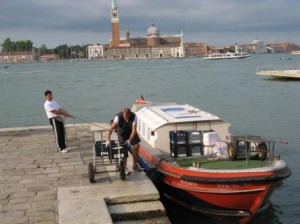
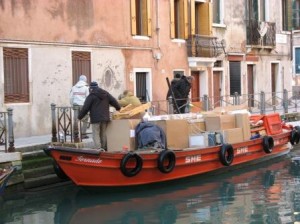

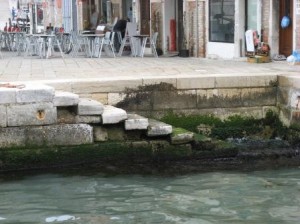
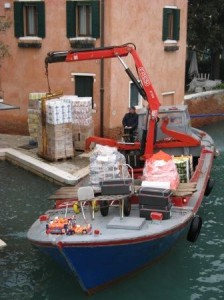
- I know they’re heavy, but all this boat to carry a few watermelons?
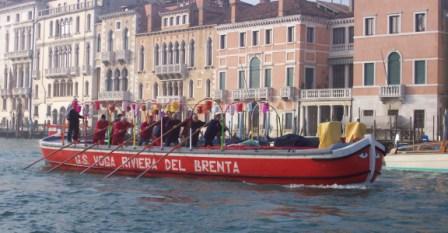
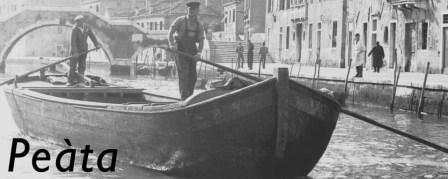
Traffic patterns: The problem isn’t merely the number and type of boats, but where they are. Obviously, the more boats you have, the more waves they will create, and where space is limited (most canals in Venice) these waves quickly accumulate into a roiling mass that dissipates with extreme difficulty. They are forced to go back and forth, hitting anything they come into contact with, until they finally wear themselves out and die.
There are canals where the waves don’t expire for hours: the Grand Canal (unfortunately), the Rio Novo, the Rio di Noale, the Canale di Tessera toward the airport, the Canale delle Fondamente Nuove, and above all, the Canale della Giudecca.
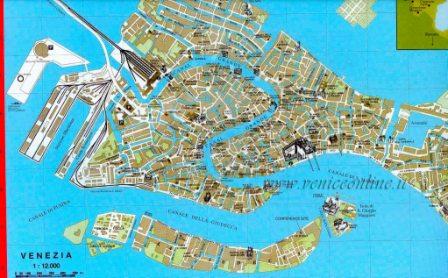
This broad, deep channel has become Venice’s Cape Horn. It is a stretch of water 1.5 miles long [2 km] and 1,581 feet [482 m] wide, and is the shortest and fastest way to get from the Maritime Zone (cruise ship passengers, tourist groups from buses at Tronchetto, barges delivering goods of every sort) to the Bacino of San Marco. One study revealed that the biggest waves in the Lagoon are here; an even more recent survey, conducted with a new telecamera system installed by the Capitaneria di Porto, provided some specific numbers: 1,000 boats an hour transit here, or 10,000 in an ordinary workday. In the summer, there are undoubtedly more, seeing that an “ordinary workday” includes masses of tourists.
One reason there are so many boats is due to the large number of barges, rendered necessary by an exotic system for distributing goods. If you are a restaurant and need paper products, they come on a barge. If you need tomato paste, it comes on another barge. If you need wine, it comes on another barge. In one especially busy internal canal, the amount of cargo and number of barges was analyzed, and it turns out that the stuff on 96 barges could have fit onto three. But never forget the fundamental philosophy: “Io devo lavorare” (I have to work).
The types of boats: Their weight and length. The shape of their hulls. Their motors (horsepower and propeller shape). All these factors influence the waves that they create.
A number of intelligent and effective changes have been proposed over time, most of which that would not be particularly complicated, but which would cost money. So far no one has shown that they consider these changes to be a worthwhile investment.
Example: The original motor taxis (c. 1930), apart from being smaller than those of today, positioned their motors in the center of the boat. When the hulls (and motors) became larger, everyone moved the motor to the stern, which immediately creates bigger waves. But subsequent improvement in motors and their fuels means that today it would be feasible to maintain the current size of the taxi while moving the motor to the center once again, thereby immediately minimizing its waves. Feasible, but no one is interested.
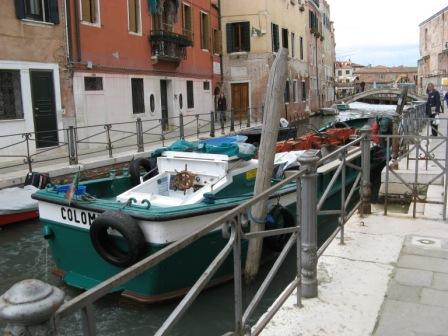
Speed: This is utterly fundamental. Speed limits were introduced in 2002 to confront the already serious problem of the waves; the average legal range, depending on what canal you’re in, is between 5-7 km/h. But tourist mega-launches, barges, taxis — almost every motorized boat in Venice has the same need: To get where they’re going as quickly as possible.
This need has been imposed by the demands of mass tourism, which involves moving the maximum amount of cargo (people, laundry, bottled water, etc.) often many times during the day. Everyone makes up a timetable which suits them and then makes it work.
Studies by the Venice Project Center have revealed several speedy facts in crisp detail.
- The height of the waves increases exponentially as speed increases. A small barge traveling at 5 km/h would produce a wake about 2 cm high. The same boat going at 10 km/h produces a wake of nearly 15 cm. (Multiply the speed by 2, multiply the wake by 7.)
- Virtually all boats exceed the speed limit. The average speed on all boats in all canals was 12 km/h, which is more than 7 km/h over the maximum speed limit.
- Therefore, reducing the speed of the boats would drastically decrease the size of their wakes.
Speed limits would have a positive effect (if they were obeyed) but only if certain laws of hydrodynamics were taken into account, such as the one governing the wake produced relative to the weight of the boat. Here the speed limits have been adjusted to permit the vaporettos (waterbuses), among the heaviest daily craft, to go — not slower, which would be correct — but as fast as the timetable requires.
You can change the laws on speed limits all you want — you’ll never change the laws of physics.
Oh yes: there will be waves.
Next: Part Four: The lagoon experience

